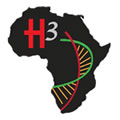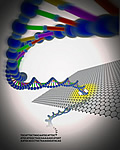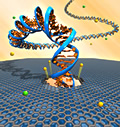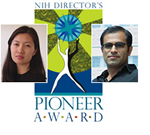Division of Extramural Research News Features
September 20, 2012:
Building a Biobank to Explore Mysteries of the Genome
 The architects of the biobank wanted nothing left to chance and everything well documented. That's why they developed 150 standard operating procedures to ensure that tissue samples were collected, processed, and stored in exactly the same way. And they collected data on the best temperatures for shipping the samples across the United States. All that planning is paying off for the Genotype-Tissue Expression (GTEx) project, which will use the samples to investigate how genes are regulated in health and disease.
The architects of the biobank wanted nothing left to chance and everything well documented. That's why they developed 150 standard operating procedures to ensure that tissue samples were collected, processed, and stored in exactly the same way. And they collected data on the best temperatures for shipping the samples across the United States. All that planning is paying off for the Genotype-Tissue Expression (GTEx) project, which will use the samples to investigate how genes are regulated in health and disease. (
more)
May 29, 2012: NHGRI awards funding to develop tools for genome sequence analyses
 The goal of sequencing a human genome for $1000 is well within reach, but that's just the beginning of the story. Once a genome is sequenced, researchers are left with the formidable challenge of analyzing and interpreting its embedded code - a complex task that requires sophisticated data analysis tools.
The goal of sequencing a human genome for $1000 is well within reach, but that's just the beginning of the story. Once a genome is sequenced, researchers are left with the formidable challenge of analyzing and interpreting its embedded code - a complex task that requires sophisticated data analysis tools. (
more)
May 14, 2012: NHGRI to host symposium on model organism Encyclopedia of DNA Elements project
 On June 20-21, NHGRI will host a special symposium to celebrate modENCODE, an NHGRI project that nears completion this year. The goal of modENCODE was to create a comprehensive catalog of functional elements in the Drosophila melanogaster (fruit fly) and Caenorhabditis elegans (worm) and freely distribute the data to the research community.
On June 20-21, NHGRI will host a special symposium to celebrate modENCODE, an NHGRI project that nears completion this year. The goal of modENCODE was to create a comprehensive catalog of functional elements in the Drosophila melanogaster (fruit fly) and Caenorhabditis elegans (worm) and freely distribute the data to the research community. (
more)
March 29, 2012: 1000 Genomes Project data available on Amazon Cloud
 The world's largest set of data on human genetic variation — produced by the international 1000 Genomes Project — is now publicly available on the Amazon Web Services (AWS) cloud, the National Institutes of Health (NIH) and AWS jointly announced today.
The world's largest set of data on human genetic variation — produced by the international 1000 Genomes Project — is now publicly available on the Amazon Web Services (AWS) cloud, the National Institutes of Health (NIH) and AWS jointly announced today. (
more)
February 24, 2012: NIDA and NHGRI announce new PhenX measures for substance abuse and addiction
 New standardized substance abuse and addiction measures, published February 24 on the PhenX Toolkit, will make it easier for researchers to combine studies and gain the much-needed statistical power to identify gene-gene or gene-environment interactions. The substance abuse and addiction measures are part of the Consensus Measures for Phenotype and eXposures Toolkit (PhenX).
New standardized substance abuse and addiction measures, published February 24 on the PhenX Toolkit, will make it easier for researchers to combine studies and gain the much-needed statistical power to identify gene-gene or gene-environment interactions. The substance abuse and addiction measures are part of the Consensus Measures for Phenotype and eXposures Toolkit (PhenX). (
more)
October 5, 2011:
ENCODE RFAs Expand Effort to Understand the Genome
 On October 4, the National Human Genome Research Institute (NHGRI) released three new Requests for Applications (RFAs) in which it announced plans to invest more than $120 million over four years (or about $31.5 million in FY 2012) to expand Encyclopedia of DNA Elements (ENCODE) research.
On October 4, the National Human Genome Research Institute (NHGRI) released three new Requests for Applications (RFAs) in which it announced plans to invest more than $120 million over four years (or about $31.5 million in FY 2012) to expand Encyclopedia of DNA Elements (ENCODE) research. (
more)
September 26, 2011: Submit your bold ideas now for transformative research awards
 Researchers with bold, paradigm-shifting ideas that will accelerate the translation of research into improved health outcomes can now apply for up to $25 million from the NIH Director's Transformative Research Award initiative.
Researchers with bold, paradigm-shifting ideas that will accelerate the translation of research into improved health outcomes can now apply for up to $25 million from the NIH Director's Transformative Research Award initiative. (
more)
September 26, 2011: NHGRI funds return of results studies, forms expert consortium
 The National Human Genome Research Institute (NHGRI) today awarded seven grants, totaling $5.7 million, aimed at untangling one of the knottiest ethical issues facing genomic researchers. Under the microscope are issues around if, when and how researchers should return to study participants information about their risk for diseases or conditions discovered during studies of their genomes.
The National Human Genome Research Institute (NHGRI) today awarded seven grants, totaling $5.7 million, aimed at untangling one of the knottiest ethical issues facing genomic researchers. Under the microscope are issues around if, when and how researchers should return to study participants information about their risk for diseases or conditions discovered during studies of their genomes. (
more)
August 31, 2011: Leaping Lizards! Researchers sequence first lizard genome
 If Little Orphan Annie had a DNA sequencing machine at Daddy Warbucks' mansion, she would probably start by sequencing the genome of a lizard to see why it leaped. And, she might be interested to discover that some elements of the lizard genome are active, mobile and, yes, still leaping. That's what researchers have discovered from analyzing the genome of the first lizard, the North American green anole.
If Little Orphan Annie had a DNA sequencing machine at Daddy Warbucks' mansion, she would probably start by sequencing the genome of a lizard to see why it leaped. And, she might be interested to discover that some elements of the lizard genome are active, mobile and, yes, still leaping. That's what researchers have discovered from analyzing the genome of the first lizard, the North American green anole. (
more)
August 29, 2011: Grant Writing: Advice from an NHGRI Pro
 The most successful scientific researchers hone their grant writing skills in order to compete for increasingly scarce funding. The National Human Genome Research Institute wants to help you write successful grant applications with tips to guide you through the process from Bettie Graham, Ph.D., a pro in grants administration for more than 30 years.
The most successful scientific researchers hone their grant writing skills in order to compete for increasingly scarce funding. The National Human Genome Research Institute wants to help you write successful grant applications with tips to guide you through the process from Bettie Graham, Ph.D., a pro in grants administration for more than 30 years. (
more)
August 24, 2011: Applicants Wanted: Funding Now Available for H3Africa
 African researchers may now apply for funding to build genomic research facilities and expertise and to conduct genomic studies in Africa. The grants are part of the Human Heredity and Health in Africa project, or H3Africa, which aim to identify rare genetic variations in Africans that may affect people around the world.
African researchers may now apply for funding to build genomic research facilities and expertise and to conduct genomic studies in Africa. The grants are part of the Human Heredity and Health in Africa project, or H3Africa, which aim to identify rare genetic variations in Africans that may affect people around the world. (
more)
August 1, 2011: eMERGE network funding expands, adds pediatric studies
 By linking data about patients' genes with descriptions of their diseases via Electronic Medical Records (EMR), doctors may someday be able to customize patients' treatments and outcomes. This is the goal of the Electronic Medical Records and Genomics, or eMERGE, network, which was formed in 2007 by NHGRI with support from the National Institute of General Medical Sciences.
By linking data about patients' genes with descriptions of their diseases via Electronic Medical Records (EMR), doctors may someday be able to customize patients' treatments and outcomes. This is the goal of the Electronic Medical Records and Genomics, or eMERGE, network, which was formed in 2007 by NHGRI with support from the National Institute of General Medical Sciences. (
more)
July 18, 2011: NHGRI's Ethical, Legal and Social Implications Research Program Updates Priorities
 NHGRI's Ethical, Legal and Social Implications (ELSI) research program has re-focused its research to stay in step with genomic advances. The program is now aligned with NHGRI's new strategic plan for the future of genomics, Charting a Course for Genomic Medicine from Base Pairs to Bedside published in the journal Nature in February. NHGRI has issued three new program announcements to support studies that address the most pressing ELSI issues.
NHGRI's Ethical, Legal and Social Implications (ELSI) research program has re-focused its research to stay in step with genomic advances. The program is now aligned with NHGRI's new strategic plan for the future of genomics, Charting a Course for Genomic Medicine from Base Pairs to Bedside published in the journal Nature in February. NHGRI has issued three new program announcements to support studies that address the most pressing ELSI issues. (
more)
May 23, 2011: Funding Now Available for Technology Development to Catalog and Analyze Function of Genomes
 The National Human Genome Research Institute is offering up to $5.75 million in new funding opportunities to support the development and use of novel analytical methods and efficient high-throughput technologies to comprehensively characterize the organization and function of genomes. The work builds on both the ENCODE and modENCODE projects, which catalog elements that are part of the genome that control gene activity in cells.
The National Human Genome Research Institute is offering up to $5.75 million in new funding opportunities to support the development and use of novel analytical methods and efficient high-throughput technologies to comprehensively characterize the organization and function of genomes. The work builds on both the ENCODE and modENCODE projects, which catalog elements that are part of the genome that control gene activity in cells. (
more)
May 16, 2011: DNA Sequences: Assembly Required
 Leaders of the Genome 10K project, an effort to collect and sequence the DNA of 10,000 vertebrate species have tapped into "crowdsourcing" to improve how all those eventual sequenced genomes are assembled for analysis. Last week, the initial results of The Assemblathon a crowdsourced research genome assembly challenge associated with the Genome 10K project, were presented at the Biology of Genomes meeting at Cold Spring Harbor Laboratory in New York .
Leaders of the Genome 10K project, an effort to collect and sequence the DNA of 10,000 vertebrate species have tapped into "crowdsourcing" to improve how all those eventual sequenced genomes are assembled for analysis. Last week, the initial results of The Assemblathon a crowdsourced research genome assembly challenge associated with the Genome 10K project, were presented at the Biology of Genomes meeting at Cold Spring Harbor Laboratory in New York . (
more)
April 25, 2011: Ethical, legal and social issues of genomic research spotlighted at ELSI Congress 2011
 Researchers confronted a plethora of plenaries, sessions, workshops and posters on the ethical, legal and social implications (ELSI) of genomic research at Exploring the ELSI Universe, the 2011 ELSI Research Congress held April 12-14 in Chapel Hill, N.C. The meeting offered 350 attendees sessions on diverse ELSI topics, from the genetics of antisocial behavior to the relationship between tissue donors and biobanks.
Researchers confronted a plethora of plenaries, sessions, workshops and posters on the ethical, legal and social implications (ELSI) of genomic research at Exploring the ELSI Universe, the 2011 ELSI Research Congress held April 12-14 in Chapel Hill, N.C. The meeting offered 350 attendees sessions on diverse ELSI topics, from the genetics of antisocial behavior to the relationship between tissue donors and biobanks. (
more)
April 19, 2011:
New User's Guide and Tutorial Helps Disease Researchers Interpret Human Genome
 The ENCyclopedia of DNA Elements (ENCODE) Consortium published a user's guide and tutorial in the April 2011 issue of PLoS Biology. The tutorials are expected to help researchers use the insights into cellular regulation of the genome and the networks of biological interactions of the parts identified by ENCODE to advance their own studies.
The ENCyclopedia of DNA Elements (ENCODE) Consortium published a user's guide and tutorial in the April 2011 issue of PLoS Biology. The tutorials are expected to help researchers use the insights into cellular regulation of the genome and the networks of biological interactions of the parts identified by ENCODE to advance their own studies. (
more)
March 8, 2011: NHGRI Funds Now Available to Include Standard Measures in Genomic Studies
 NHGRI is pleased to announce supplemental funding to researchers who incorporate standardized measures available from the Consensus Measures for Phenotype and eXposures (PhenX) Toolkit. Such measures allow researcher to accurately record research subjects' physical characteristics and environmental exposures..
NHGRI is pleased to announce supplemental funding to researchers who incorporate standardized measures available from the Consensus Measures for Phenotype and eXposures (PhenX) Toolkit. Such measures allow researcher to accurately record research subjects' physical characteristics and environmental exposures.. (
more)
February 7, 2011: The Road to the $1000 Genome Via Nanopores - A Roundup of Sequencing Technology Developments
 We are nearing the day when a small blood sample can be rapidly sequenced on a handheld device in your doctor's office. By analyzing your DNA, your doctor will have critical information on your current health status and the diseases to which you might be vulnerable in the future. Nanopore sequencing, as it is known, is just one of many promising technologies currently being pursued by National Human Genome Research grantees to achieve high quality human genome sequencing for $1000 or less.
We are nearing the day when a small blood sample can be rapidly sequenced on a handheld device in your doctor's office. By analyzing your DNA, your doctor will have critical information on your current health status and the diseases to which you might be vulnerable in the future. Nanopore sequencing, as it is known, is just one of many promising technologies currently being pursued by National Human Genome Research grantees to achieve high quality human genome sequencing for $1000 or less. (
more)
January 10, 2011: Applicants Wanted: Funding Now Available for New Phase of NHGRI Large-Scale Sequencing Program
 The National Human Genome Research Institute (NHGRI) has started the new year with a bang, offering about $90 million in new funding opportunities to continue its support of large genome sequencing and analysis centers that are the hallmark of its flagship Large-Scale Sequencing Program.
The National Human Genome Research Institute (NHGRI) has started the new year with a bang, offering about $90 million in new funding opportunities to continue its support of large genome sequencing and analysis centers that are the hallmark of its flagship Large-Scale Sequencing Program.
(
more)
August 2010: The Road to the $1000 Genome — A Roundup of Sequencing Technology Developments
 Recent news articles marking the tenth anniversary of the announcement of the first draft sequence of the human genome also predicted the rise of DNA sequencing technologies that sequence a human genome for $1,000 or less in the next three to five years, a development that would change the face of biomedical research and clinical practice.
Recent news articles marking the tenth anniversary of the announcement of the first draft sequence of the human genome also predicted the rise of DNA sequencing technologies that sequence a human genome for $1,000 or less in the next three to five years, a development that would change the face of biomedical research and clinical practice.
(
more)
July 2010: NIH Receives Donation of Knockout Mice Collection Used To Study Secreted and Transmembrane Proteins
 A full 472 knockout mouse lines — all extensively characterized (phenotyped) — are now publicly available from the National Institutes of Health's Mutant Mouse Regional Resource Center (MMRRC) at the University of California, Davis. Distribution of the lines is supported by the National Center for Research Resources (NCRR) and the NIH-funded Knockout Mouse Project (KOMP) repository, operated by UC Davis and the Children's Hospital Oakland Research Institute in Oakland, Calif.
A full 472 knockout mouse lines — all extensively characterized (phenotyped) — are now publicly available from the National Institutes of Health's Mutant Mouse Regional Resource Center (MMRRC) at the University of California, Davis. Distribution of the lines is supported by the National Center for Research Resources (NCRR) and the NIH-funded Knockout Mouse Project (KOMP) repository, operated by UC Davis and the Children's Hospital Oakland Research Institute in Oakland, Calif.
(
more)
May 2010: NHGRI Provides Sneak Peek into Future of Genome Sequencing Program
 The NHGRI Large-Scale Sequencing Program comes up for renewal in fiscal year 2011 and the institute's program managers recently recommended to the National Advisory Council of Human Genome Research that the program's sequencing and analysis centers remain on line. The rational is fairly straightforward: there is still so much to learn and the expertise provided by such centers is the most efficient way to learn it. Moreover, the current sequencing centers already have shown their ability to help this field of research transition from basic studies to those with medical value.
The NHGRI Large-Scale Sequencing Program comes up for renewal in fiscal year 2011 and the institute's program managers recently recommended to the National Advisory Council of Human Genome Research that the program's sequencing and analysis centers remain on line. The rational is fairly straightforward: there is still so much to learn and the expertise provided by such centers is the most efficient way to learn it. Moreover, the current sequencing centers already have shown their ability to help this field of research transition from basic studies to those with medical value.
(
more)
April 2010: Answers to Genome Analysis May Be in the Clouds
 With NexGen sequencing machines generating cheap DNA data in record amounts, genomics researchers have been on "cloud nine". Except for one thing: the data pouring out of the gene machines are swamping computer infrastructures everywhere — from the smallest RO1 lab to the biggest sequencing center. A solution, however, may be in the clouds — clouds of computers, that is.
With NexGen sequencing machines generating cheap DNA data in record amounts, genomics researchers have been on "cloud nine". Except for one thing: the data pouring out of the gene machines are swamping computer infrastructures everywhere — from the smallest RO1 lab to the biggest sequencing center. A solution, however, may be in the clouds — clouds of computers, that is.
(
more)
February 2010: Dr. William M. Gelbart, NHGRI Advisor and Grantee, Receives Distinguished Service Award from Genetics Society of America
 National Human Genome Research Institute advisor and grantee, William M. Gelbart, Ph.D., Harvard University professor of molecular and cell biology, is the recipient of the 2010 Genetic Society of America's (GSA) George W. Beadle award for "outstanding contributions to the community of genetic researchers." Dr. Gelbart was nominated and selected for the honor by his peers for the value of his contributions to the field of genetics.
National Human Genome Research Institute advisor and grantee, William M. Gelbart, Ph.D., Harvard University professor of molecular and cell biology, is the recipient of the 2010 Genetic Society of America's (GSA) George W. Beadle award for "outstanding contributions to the community of genetic researchers." Dr. Gelbart was nominated and selected for the honor by his peers for the value of his contributions to the field of genetics.
(
more)
October 2009: NHGRI Uses Recovery Act Funds to Accelerate Genome Research to Improve Human Health
 The National Human Genome Research Institute
The National Human Genome Research Institute awards more than $113 million provided by the American Recovery and Reinvestment Act. The new awards, added to NHGRI's regularly appropriated $367 million budget, will stimulate ground-breaking research ranging from studies aimed at understanding the human genome to those intended to lead to improvements in the prevention, diagnosis and treatment of human illness.
(
more)
September 2008: NHGRI-Funded Scientists Win NIH Director's Pioneer Award

Two National Human Genome Research Institute grantees, Alice Y. Ting, Ph.D., and Saeed Tavazoie, Ph.D., are among the 15 scientists of exceptional creativity chosen to receive a 2008 NIH Director's Pioneer Award. The awards enable researchers to pursue innovative approaches that could possibly transform biomedical and behavioral science.
(
more)
June 2007: Researchers Can Now Apply for Access to Data from NHGRI Cancer Sequencing Projects

The National Human Genome Research Institute (NHGRI) is now accepting requests from researchers who want access to data from two cancer sequencing projects being conducted as part of its Medical Sequencing Program. The goal is to harness the power of NHGRI's large-scale sequencing centers to help turn DNA sequencing into a tool for clinical research and medical practice.
(
more)
October 2005: Telomere Researcher Wins NIH Director's Pioneer Award

Titia de Lange, Ph.D., Leon Hess professor and head of the Laboratory of Cell Biology and Genetics at The Rockefeller University in New York, was named one of 13 recipients of a 2005 National Institutes of Health (NIH) Director's Pioneer Award. The award, announced on Sept. 29, will provide Dr. de Lange with up to $500,000 in direct costs per year for five years to fund research in teleomeres. The National Human Genome Research Institute (NHGRI) will fund de Lange's award for four out of the five years, totaling $2 million in support.
(
more)
October 2004: NHGRI-Funded Researcher Among Pioneer Awardees

Stephen R. Quake, Ph.D., a researcher funded by the National Human Genome Research Institute (NHGRI), is among the first recipients of the National Institutes of Health (NIH) Director's Pioneer Award, which were announced on Wednesday, September 29, 2004. Dr. Quake, formerly of the California Institute of Technology, and currently a professor of bioengineering at Stanford University has received substantial funding from NHGRI for highly innovative research that may dramatically improve the technologies used to advance genomics. NHGRI first supported Dr. Quake with a FIRST award for new investigators in 1997 for his work in developing integrated nanofluidic chip systems and novel chemistry for single molecule DNA sequencing. (
more)
Top of page
Last Updated: May 29, 2012

























 The National Human Genome Research Institute awards more than $113 million provided by the American Recovery and Reinvestment Act. The new awards, added to NHGRI's regularly appropriated $367 million budget, will stimulate ground-breaking research ranging from studies aimed at understanding the human genome to those intended to lead to improvements in the prevention, diagnosis and treatment of human illness.
(more)
The National Human Genome Research Institute awards more than $113 million provided by the American Recovery and Reinvestment Act. The new awards, added to NHGRI's regularly appropriated $367 million budget, will stimulate ground-breaking research ranging from studies aimed at understanding the human genome to those intended to lead to improvements in the prevention, diagnosis and treatment of human illness.
(more)
 Two National Human Genome Research Institute grantees, Alice Y. Ting, Ph.D., and Saeed Tavazoie, Ph.D., are among the 15 scientists of exceptional creativity chosen to receive a 2008 NIH Director's Pioneer Award. The awards enable researchers to pursue innovative approaches that could possibly transform biomedical and behavioral science.
(more)
Two National Human Genome Research Institute grantees, Alice Y. Ting, Ph.D., and Saeed Tavazoie, Ph.D., are among the 15 scientists of exceptional creativity chosen to receive a 2008 NIH Director's Pioneer Award. The awards enable researchers to pursue innovative approaches that could possibly transform biomedical and behavioral science.
(more)
 The National Human Genome Research Institute (NHGRI) is now accepting requests from researchers who want access to data from two cancer sequencing projects being conducted as part of its Medical Sequencing Program. The goal is to harness the power of NHGRI's large-scale sequencing centers to help turn DNA sequencing into a tool for clinical research and medical practice.
(more)
The National Human Genome Research Institute (NHGRI) is now accepting requests from researchers who want access to data from two cancer sequencing projects being conducted as part of its Medical Sequencing Program. The goal is to harness the power of NHGRI's large-scale sequencing centers to help turn DNA sequencing into a tool for clinical research and medical practice.
(more)
 Titia de Lange, Ph.D., Leon Hess professor and head of the Laboratory of Cell Biology and Genetics at The Rockefeller University in New York, was named one of 13 recipients of a 2005 National Institutes of Health (NIH) Director's Pioneer Award. The award, announced on Sept. 29, will provide Dr. de Lange with up to $500,000 in direct costs per year for five years to fund research in teleomeres. The National Human Genome Research Institute (NHGRI) will fund de Lange's award for four out of the five years, totaling $2 million in support.
(more)
Titia de Lange, Ph.D., Leon Hess professor and head of the Laboratory of Cell Biology and Genetics at The Rockefeller University in New York, was named one of 13 recipients of a 2005 National Institutes of Health (NIH) Director's Pioneer Award. The award, announced on Sept. 29, will provide Dr. de Lange with up to $500,000 in direct costs per year for five years to fund research in teleomeres. The National Human Genome Research Institute (NHGRI) will fund de Lange's award for four out of the five years, totaling $2 million in support.
(more)
 Stephen R. Quake, Ph.D., a researcher funded by the National Human Genome Research Institute (NHGRI), is among the first recipients of the National Institutes of Health (NIH) Director's Pioneer Award, which were announced on Wednesday, September 29, 2004. Dr. Quake, formerly of the California Institute of Technology, and currently a professor of bioengineering at Stanford University has received substantial funding from NHGRI for highly innovative research that may dramatically improve the technologies used to advance genomics. NHGRI first supported Dr. Quake with a FIRST award for new investigators in 1997 for his work in developing integrated nanofluidic chip systems and novel chemistry for single molecule DNA sequencing. (more)
Stephen R. Quake, Ph.D., a researcher funded by the National Human Genome Research Institute (NHGRI), is among the first recipients of the National Institutes of Health (NIH) Director's Pioneer Award, which were announced on Wednesday, September 29, 2004. Dr. Quake, formerly of the California Institute of Technology, and currently a professor of bioengineering at Stanford University has received substantial funding from NHGRI for highly innovative research that may dramatically improve the technologies used to advance genomics. NHGRI first supported Dr. Quake with a FIRST award for new investigators in 1997 for his work in developing integrated nanofluidic chip systems and novel chemistry for single molecule DNA sequencing. (more)





